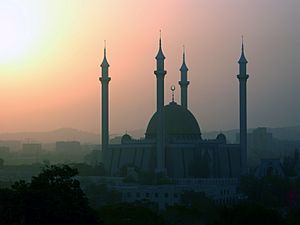Haze facts for kids

Haze is when the air looks cloudy or smoky, making it hard to see clearly. It's like a thin fog, but it's caused by tiny particles floating in the air, not just water droplets. Sometimes, haze can make it difficult for people to breathe and can even make them sick.
Contents
What is Haze?
The World Meteorological Organization (WMO) groups haze with other things that make the air cloudy or hard to see through. These include fog, mist, smoke, volcanic ash, dust, sand, and even snow.
What Causes Haze?
Haze happens when tiny bits of stuff, called particles, float in the air. These particles can come from many places. For example, when farmers plough dry fields, dust can fly into the air. Cars and factories also release tiny particles. Big fires, like wildfires, create a lot of smoke that can cause haze too.
How Haze Looks and Feels
If you see haze from far away, like from an airplane, it might look brownish or bluish. This depends on where the sun is. Mist, which is like a very light fog, usually looks bluish-grey. People often think haze happens in dry air, while mist needs humid (wet) air. But sometimes, haze particles can help mist form. When this happens, it's called "wet haze."
Wet Haze and Its Chemistry
When scientists talk about haze, they often mean the "wet haze" type. This kind of haze is made of tiny particles called aerosols that reduce how far you can see. These aerosols often form from gases like sulfur dioxide, which comes from burning things. These gases change into small drops of sulfuric acid in the air. This process happens more easily when there is sunlight, a lot of moisture in the air, and when the air isn't moving much. Some wet haze particles also come from natural compounds released by trees. Because of these reasons, wet haze is usually seen more often in warmer seasons. Large areas of haze, covering thousands of kilometers, can form during favorable summer conditions.
Images for kids
-
Haze over the Mojave Desert from a brush fire in Santa Barbara, California, seen as the Sun descends on the 2016 June solstice, allows the Sun to be photographed without a filter.
-
Haze as smoke pollution over the Mojave from fires in the Inland Empire, June, 2016, demonstrates the loss of contrast to the Sun, and the landscape in general.
-
Haze causing red clouds, due to the scattering of light on smoke particles, also known as Rayleigh scattering during Mexico's forest fire season.
-
Haze in Monterrey, Mexico during grassland fires.
See also
 In Spanish: Calima (meteorología) para niños
In Spanish: Calima (meteorología) para niños





